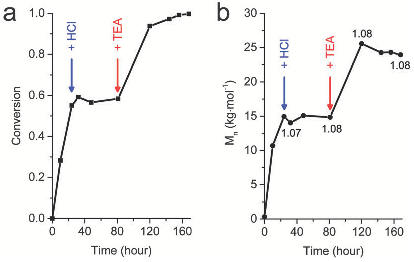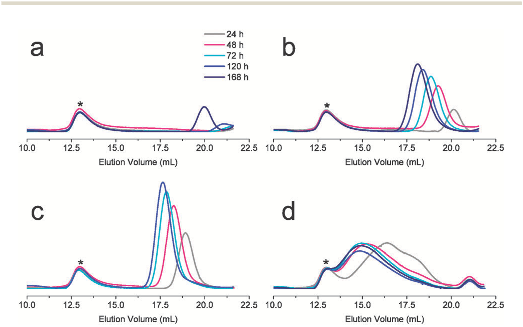Abstract: Since 1906, when Leuchs synthesized the first R-amino acid N-carboxyanhydrides (NCAs),1 later referred to as Leuchs’ anhydrides, a great number of publications dealing with the ring-opening polymerization (ROP) of these monomers (Scheme 1) has accumulated. This interest stems from the wide variety of polypeptides that this polymerization can generate. The synthetic polypeptides produced from the NCAs, although far from being monodisperse or constructed from a precise sequence and composition of R-amino acid residues, possess the ability, as their natural relative-proteins, to form R-helix and -sheet motifs. These secondary structures contribute significantly to the self-assembling character of polypeptide chains, leading to novel supramolecular structures with potential biomedical and pharmaceutical applications.2 As for their natural counterparts, it is important for such synthetic polypeptides to be well-defined with high molecular and structural homogeneity in order to favor their selfassembly into precisely defined nanostructures, a requirement for appropriate functionality. It was not until 1997, when Deming3 reported the first living initiating system for the ROP of NCAs, that the synthesis of well-defined polypeptides was achieved. Following this first report, other alternative living initiating systems or methods have also been developed. These living systems lead to well-defined homo-/copolypeptides and hybrids, with high molecular weight and structural homogeneity. Nevertheless, the earlier studies served as the springboard for developments in the whole area of polypeptide synthesis. Several excellent reviews4 have been dedicated to the ROP of NCAs, elucidating the mechanistic aspects of this polymerization. However, only a few have addressed the synthesis of polypeptide-based materials with different macromolecular architectures.4c,5,6 This review is divided into three parts. The first highlights the mechanistic developments of the ROP of NCAs from the conventional to the living initiating systems/methods; the second is dedicated to the synthesis of polypeptides and polypeptide hybrids with different macromolecular architectures; and the third deals with surface-bound polypeptides. Surface-bound polypeptides were incorporated in the review due to the great interest in biologically active surfaces for medical diagnostics and sensors.7



